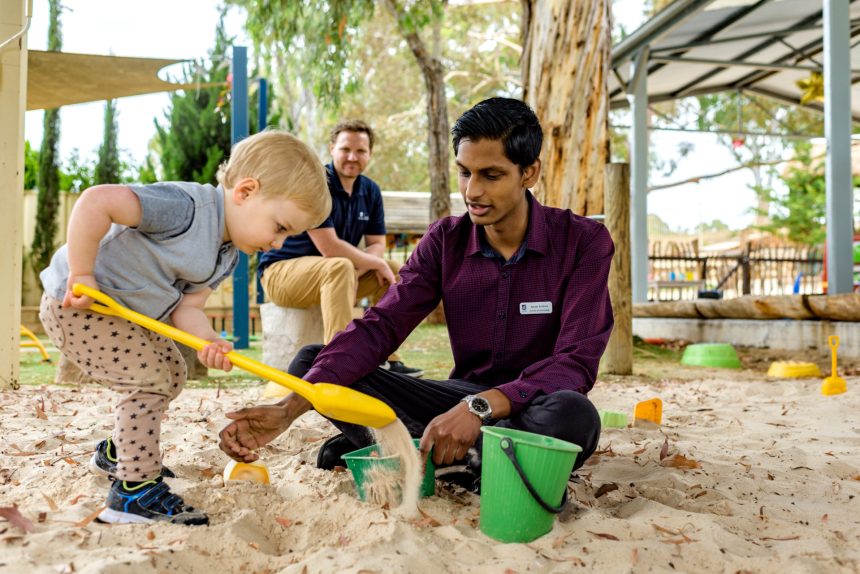Education experts at the University of South Australia (UniSA) are calling for a national childhood workforce strategy to encourage more men into early learning and childcare professions. The flow-on from that initiative, one expert says, may also help address the question many families ask when their children move through primary education across Australia: where are all the male teachers?
The call for more men in early childhood education in SA is part of the newly launched Mindaroo Thrive by Five Dad’s Alliance Action Plan for the Early Years, which aims to support fathers to take a more active role in their children’s lives.
With fewer than three per cent of men in carer and teacher roles in the early childhood education and care sector, the need for gender diversity is clear, says UniSA’s Senior Lecturer in Early Childhood Education (ECE) and Coordinator of the MENtor Program for Males in ECE, Dr Martyn Mills-Bayne.

Positive male role models in early education can have a lifelong impact
“The first five years of a child’s life are critical to healthy development, and it’s vital that children receive the best quality of care during these early years,” Dr Mills-Bayne says.
“A key part of this is ensuring that children are cared for by healthy and positive role models – which includes both men and women. Yet in childcare and early education settings, men are vastly underrepresented. And this can be to the detriment of children. Having access to positive interactions between men and women supports young children’s healthy development in all areas.”
One of the reasons why it’s important to encourage and support more males to consider teaching – whether in early childhood settings, or in primary and secondary schools – Dr Mills-Bayne says, comes back to an old adage.
“‘You can’t be what you can’t see’ helps underline the importance of radically increasing the number of male educators in the early years,” he told EducationDaily.
“Having access to a gender diverse early years workforce can provide young children with opportunities to see rich positive interactions and relationships between men and women, as well as seeing men as caring adults who value and support the learning and development of children in the first years of their lives.”
Culturally diverse school leadership is critical
The Australian Institute for Teaching and School Leadership (AITSL) recently advocated for a more culturally diverse leadership profile in schools while also highlighting the issues around gender diversity of teachers in schools:
As of 2018, there were approximately 19,712 school leaders working in Australian schools, comprising 6 per cent of all teaching staff (Australian Bureau of Statistics, 2018b; Willett, Segal, & Walford, 2014). However, the demographics of school leaders do not match the gender and cultural diversity of Australia’s student community. While the proportion of male and female students is fairly even, this is not reflected on the teacher side. Teaching is a female dominated profession – 73 per cent of all in-school staff are female and there are more female than male school leaders (Australian Bureau of Statistics, 2018b; Mckenzie, Weldon, Rowley, Murphy, & Mcmillan, 2014). (AITSL Spotlight: Diversity in School Leadership, 2019)
“While it is important to have a more gender diverse workforce in all areas of education, the early years (childcare, kindy, and junior primary) is where the biggest disparity exists,” Dr Mills-Bayne told EducationDaily.
“Male secondary teachers consistently make up about 40 per cent, and primary school teachers about 25 per cent of the teaching workforce. While society has seen a significant shift in the outdated views and stereotypes about gender roles and identities that have traditionally been attributed to men and masculinity, gender diversity in the early years continues to be extremely poor. In short, the number of male early childhood educators has been too low for too long. It is time for a radical shift in the recruitment and retention of male early childhood educators.”
Early education lays foundation for healthy growth and development
With the early years of education proving critical to children’s healthy growth in all areas of development, Dr Mills-Bayne says a diverse gender profile in the early years’ workforce adds to “the rich potential for children to see themselves reflected in the adults who educate and care for them in structured early learning”.
“Young children can benefit enormously from male teachers and carers in early childhood settings,” he says.
“Not only can men often provide increased opportunities for children to engage in ‘rough-and-tumble’ play, or to get involved in messy play and take risks, but they also represent much-needed healthy and caring role models. When young children learn from and are cared for by both men and women, we’re showing that all genders matter, so that ‘caring’ and ‘being kind’ are valued across genders. And this important learning is something they’ll take with them across their lives.”
Breaking long-established gender stereotypes is vital, he believes – “and it needs to be more strongly supported in early childcare and education”.
Societal shifts are happening – but not fast enough
Although he is pleased to see societal shifts in our understanding of gender roles have started to erode persistent stereotypes and misconceptions about the caring and educative roles of men in children’s lives, Dr Mills-Bayne says this shift has not yet created a flood of men teaching in the early years.
“Sadly, the workload and wages associated with working in early childhood education and care services schools are barriers to many young men looking at teaching and education as a career option coming out of high school, and while many of us can remember a male teacher who made a difference in our learning and confidence throughout our education experience, there are simply not enough strong male role models in the early years of education to aspire to…again, they say you can’t be what you can’t see… so until we radically supercharge the number of male early childhood educators in our centres and schools, we may not see the increase in men in the early years workforce we need,” he told EducationDaily.
Taking action to boost teacher recruitment and retention
He is calling on state and national governments to join the Dad’s Action Plan for the Early Years to help supercharge male involvement in young children’s lives with a radical shift in the recruitment and retention of male early childhood educators.
The Dad’s Action Plan has proposed a five-point plan to supercharge the involvement of fathers in their young children’s lives:
- A national strategy to support fathers to take an equal share of parenting, including a major education campaign for businesses and families
- Increased investment into tailored perinatal education and parenting support for fathers during the period from pregnancy to 5 years
- Twelve weeks of federally funded paid parental leave for fathers and non-birthing parents that does not detract from mother’s parental leave entitlements and is economically viable, so that families choose to ‘use it’ rather than ‘lose it’
- A commitment at National Cabinet to develop, implement and fund universal access to a high-quality and affordable early learning system for all children, regardless of location or circumstances
- A national early childhood workforce strategy that encourages male participation.
“If we can improve the experiences of our youngest citizens so that they’re cared for by men and women, the flow-on effects could be exponential – it’s time to step up.”








